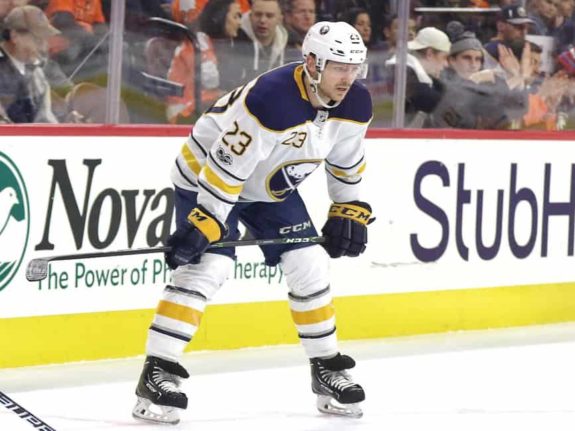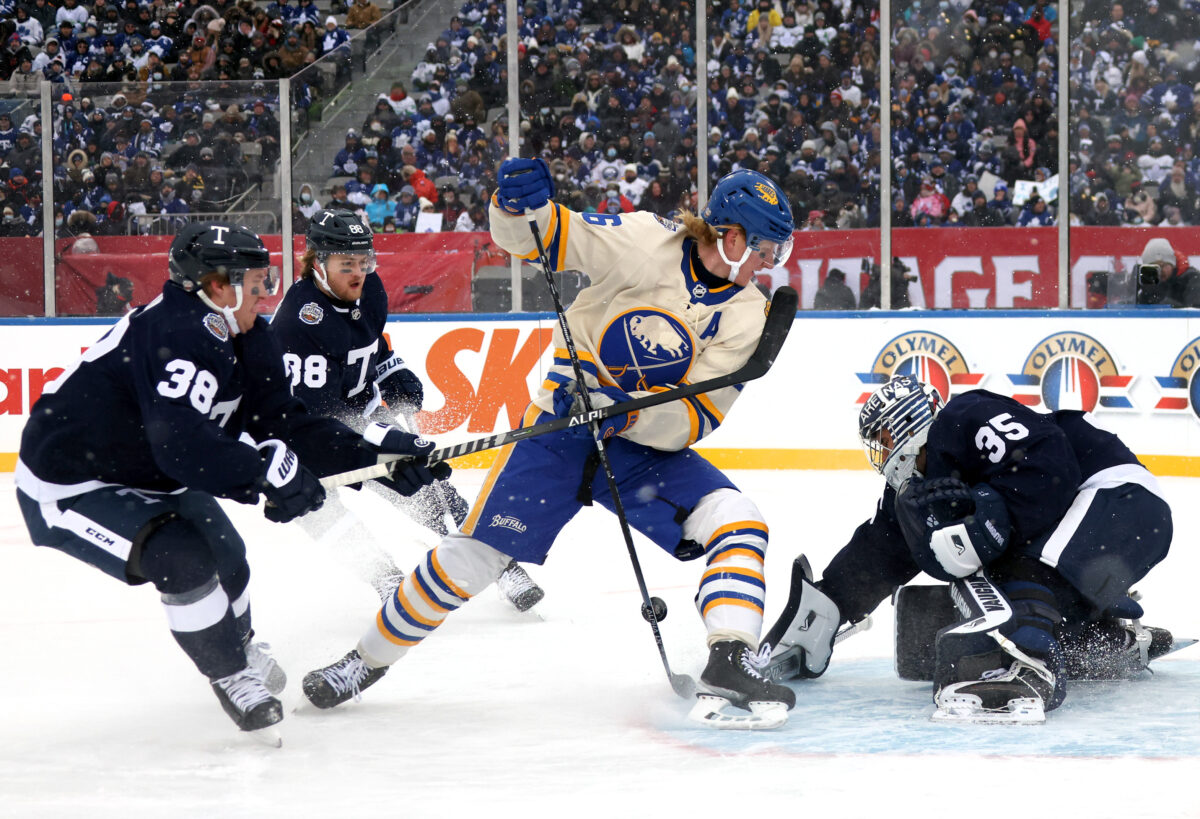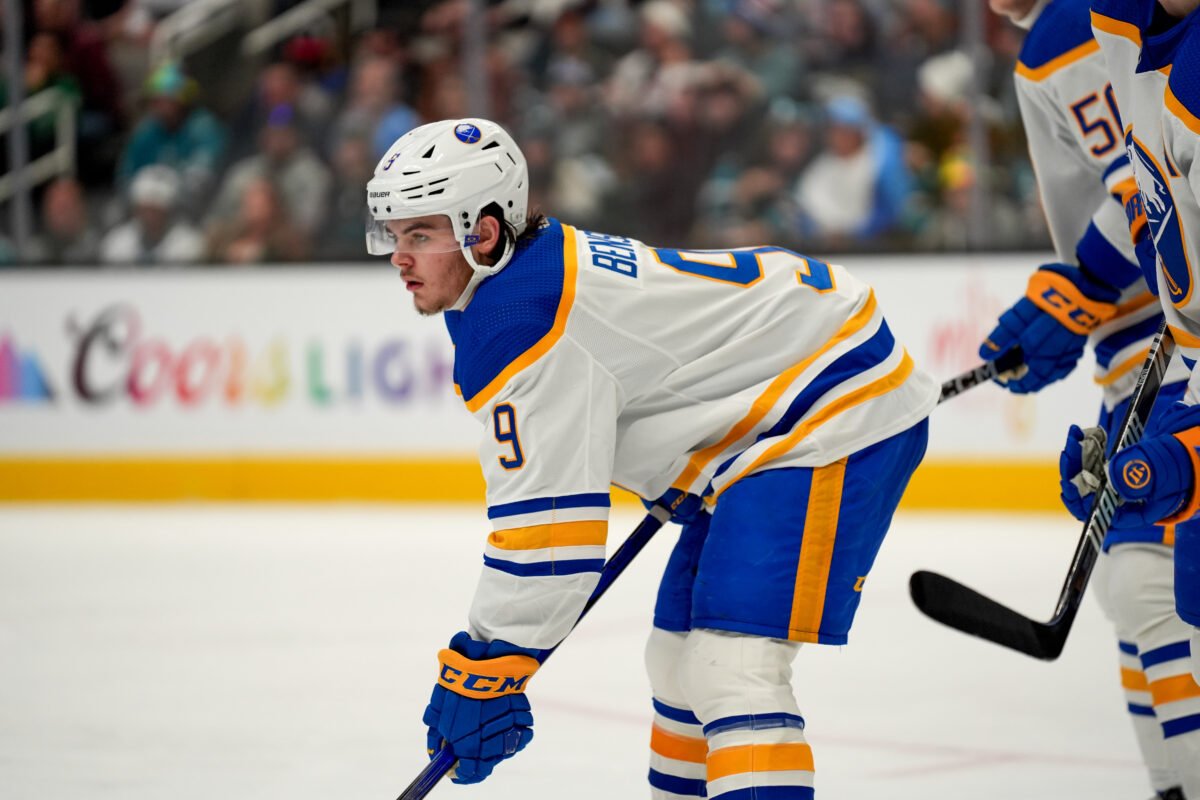The Buffalo Sabres have made 18 first-round NHL Entry Draft selections since Terry Pegula purchased the franchise midway through the 2011 season. One would think the team used these to stockpile young talent for the future and turn itself into a perennial postseason contender, right?
Wrong. The Sabres have spent veritably all of Pegula’s tenure in a perpetual rebuild and have gone through a myriad of head coaches and front office personnel in that time. Despite drafting several players who seemed to possess the talent and ability to turn a team’s fortunes around, Buffalo’s consistent organizational incompetence and upheaval prevented that from happening. And though the team seems to have finally turned a corner and has returned to playoff contention over the last two seasons, their draft picks that have turned out to be failures still stand out.
As we did with the Sabres’ biggest free-agent acquisitions under Pegula, here’s a look at those first-round selections dating back to 2014 and a fair judgment of which were wins and which were flops. 2021’s Isak Rosen and 2022’s Matthew Savoie, Jiri Kulich and Noah Ostlund won’t be considered as all are either yet to debut or haven’t played enough for a realistic judgement.
2014: Sam Reinhart- 2nd Overall
After the 2013-14 season, which can only be described as wretched, the Sabres had a reason for excitement with the second overall selection of the 2014 Draft. Though the Florida Panthers somehow won the Draft Lottery despite finishing 14 points ahead of the Sabres in the standings, Buffalo fans weren’t deterred and newly-minted general manager Tim Murray selected center Sam Reinhart of the Kootenay Ice.
The Sabres actually handled Reinhart’s initial development well, something they were not known for at the time. They brought him up for a brief run to begin the 2014-15 season but promptly returned him to Kootenay so that he wouldn’t be rushed, and it paid off in the long haul. He joined the team full-time the following season and immediately became a fixture.

In six seasons with the Sabres, the Vancouver native was a consistent contributor and recorded 20 or more goals five times. Despite this, the Sabres for some reason were unwilling to commit to him and he was never offered more than a two-year contract. This, combined with the Sabres’ struggles to progress, led to understandable frustration. By 2021, speculation became rampant that he wanted out of Buffalo and that summer he was traded to the Panthers, with whom he’s gone on to great success, reaching the Stanley Cup Final in 2023 and scoring a whopping 57 goals the following season.
Reinhart’s tenure with the team may have ended acrimoniously (or so it seemed), but it was hardly his fault. Had the Sabres at some point offered him the long-term deal that he rightly deserved, he would probably still be wearing their jersey, or at least would have for longer. He was worthy of being a second-overall selection and they should have valued him far higher than they did. Ruling: Flop.
2015: Jack Eichel- 2nd Overall
After the 2014-15 season (which somehow managed to be even more disastrous than its predecessor), the Sabres lost the Draft Lottery for a second consecutive year despite having the best odds. It caused no shortage of outrage in the City of Good Neighbors, but it wasn’t a complete loss. It meant Buffalo would miss out on the immensely-touted Connor McDavid, but the 2015 Draft had two generational talents available. Boston University center Jack Eichel instantly reinvigorated the beleaguered franchise and gave hope for the future. If the Sabres were to turn it around, he would be the reason.
As we all know by now, that didn’t happen. The Hobey Baker Award winner proved that he was worthy of the hype and never scored less than 50 points in each of his five full seasons in Buffalo, but it was all for naught at the end of the day.
Eichel was with the Sabres for seven years, and in that time, the organization fired three head coaches and two general managers. The revolving door prevented the team from achieving any improvement and they consistently spun out year after year. He openly admitted to being unhappy as a result, and it’s easy to see why. The situation worsened when the superstar sustained a serious neck injury during the 2021 season and the Sabres rejected his preferred course of treatment. It proved to be the last straw and he never appeared in the blue and gold again, being dealt to the Vegas Golden Knights that November in one of the biggest trades in recent NHL history.
Whether his departure was his or the Sabres’ fault can be argued until the end of days. But as the situation unfolded, fans turned on their former captain and labeled him a selfish, cancerous diva (a point that can also be argued). However, it would be tough even for the most fervent Eichel haters to deny that his abilities gave the Sabres the potential to win. The team was never able to get out of its own way and somehow squandered one of the best players it will ever draft. Eichel led the Golden Knights to the Stanley Cup in 2023. Ruling: Flop.
2016: Alexander Nylander- 8th Overall
After a much-improved 2015-16 season, the Sabres had the honor of hosting the 2016 Draft and kept their renewed vigor going by selecting Alexander Nylander of the Mississauga Steelheads. With Eichel, Reinhart, Ryan O’Reilly, Rasmus Ristolainen, Evander Kane and newcomer Kyle Okposo leading the charge, optimism in Buffalo was rampant and Nylander seemed like a great choice after being named the Canadian Hockey League’s 2015-16 Rookie of the Year. Since it was his only season in junior, the Sabres allowed him to spend three seasons in Rochester.
Therein lay the problem, however. Though the Swede excelled in his time with the Americans, he never seemed truly ready to make the jump to the NHL and he was limited to brief call-ups at the end of those seasons, during which he failed to impress. Though 19 total games wasn’t much of a sample, the Sabres decided to move on and he was traded to the Chicago Blackhawks in the summer of 2019.
Thankfully, the trade proved to be trash-for-treasure as the Sabres received Henri Jokiharju in return. Nylander failed to catch on in Chicago and was sent to their AHL affiliate after one season. Though he had something of an emergence with the Columbus Blue Jackets this season, Buffalo still made the right call here. Ruling: Flop.
2017: Casey Mittelstadt- 8th Overall
Sometimes you don’t realize what you have until it’s too late and that was without question the case here. Former Sabre Jason Botterill became the third GM of the Pegula Era after a disappointing 2016-17 season led to Murray’s firing. With his first pick in the role, Botterill selected Casey Mittelstadt of the Green Bay Gamblers, the first American selected by the Sabres in the first round since 2004.
Though Sabres fans were initially upset by the choice because of Mittelstadt’s performance at the scouting combine, their fears were put to rest when he tore up the 2018 World Junior Championship (coincidentally held in Buffalo) and was named MVP. But in hindsight, that success did more harm than good in the short term. Just when it seemed the Sabres had finally learned from their past mistakes of rushing prospects into the spotlight, they went back to their old ways.
After O’Reilly was sent to the St. Louis Blues in the summer of 2018, Mittelstadt was chosen to fill the void and was recalled full-time at 19 despite having just one season of NCAA experience with Minnesota. The decision backfired and it became evident very quickly that he was not yet ready for such a large role. The team realized its mistake and he was sent to Rochester for the 2019-20 season and it did seem to help him regain some form, but injuries caused him significant time in each of the next two seasons.
But, just when Sabres fans were about to declare him a lost cause, Mittelstadt posted a very strong 2022-23 season and recorded new career highs in every offensive category. Particularly, he posted 12 points in the final eight games to keep the Sabres in the hunt. He continued his strong play into the next season but, ironically, the Sabres had no choice but to trade him at the 2024 Deadline as they risked losing him in free agency due to financial constraints. Had his development not been bungled so badly he’d probably have broken out sooner, but Mittelstadt proved that he was the right choice in the end. Ruling: Win.
2018: Rasmus Dahlin- 1st Overall
Despite bringing in former Sabre and Hockey Hall of Famer Phil Housley to take over behind the bench, the Sabres’ downward spiral continued in 2017-18 and they finished last in the NHL once again. The campaign seemed to suck the life out of players and fans alike, but there was a silver lining. This time, the Sabres won the Draft Lottery and received the first overall pick for the first time since 1987. The prize awaiting them was Rasmus Dahlin of HC Frolunda, proclaimed to be a once-in-a-generation defensive talent.

Though it made him the league’s youngest player, Dahlin joined the Sabres for the 2018-19 season and immediately proved it was the right choice. His 44 points ranked second in NHL history by an 18-year-old defenseman (behind Housley) and earned him a nomination for the Calder Trophy. However, his sky-rocketing momentum declined after repeated turnover; Housley was fired in April 2019 and it was only a season and a half more before successor Ralph Krueger met the same fate. Thankfully, Don Granato was able to help his star regain himself and Dahlin turned in a breakout 2021-22, posting a new career-high 53 points and was named an NHL All-Star.
After announcing his arrival, the Swede took it a step further and posted 73 points in 78 games in 2022-23, being named an All-Star once again. Despite this, he was not named a finalist for the Norris Trophy, the only major NHL award a Sabre has never won. Nevertheless, he’s become an unquestioned team leader and could become it’s next captain after Okposo’s departure in 2024. Ruling: Win.
2019: Dylan Cozens- 7th Overall
All one needs to know about the Sabres’ 2018-19 season is that the team won 10 straight games in November (tying a franchise record) and then didn’t win consecutive games after that until the final two of the season. It made them even more of a joke and resulted in Housley being fired. Looking to turn the negative into a positive, the Sabres made history at the 2019 Draft by making Dylan Cozens of the Lethbridge Hurricanes the first-ever first-round pick born in the Yukon.
After winning gold at the 2020 World Junior Championship, Cozens made his NHL debut during the COVID-shortened 2021 season. Though just 19 at the time and despite the difficult circumstances, he immediately impressed fans and the media alike with his poise and maturity. He finished his 41-game rookie season with just 13 points but his impact was far greater than that. He continued to excel in his sophomore campaign but stumbled in the second half and endured a 17-game goal-less drought.
He posted a remarkable bounce back with 31 goals and 68 points in 2022-23 but wasn’t able to capitalize on it and regressed significantly in 2023-24. Cozens has endeared himself to fans immensely with his personality but his inconsistency has been troubling. The Sabres showed their faith by signing him to a seven-year extension and the onus is on his to show that it was the right call. He’s still just 23, but he will face increased scrutiny next season and could fall out of favor if he doesn’t turn things around. Ruling: Win (tentative).
2019: Ryan Johnson- 31st Overall
The Sabres also held the final pick of the first round in 2019 thanks to the O’Reilly trade and used it to select Ryan Johnson of the Sioux Falls Stampede. While most first round picks generate hype and excitement at the time, Johnson stayed away from the spotlight and over the next four years a number of fans probably forgot he existed. He chose to honor his commitment to the University of Minnesota and stayed there for the entirety of his collegiate eligibility, a rare move for such a prominent selection.
For a while it seemed like the defenseman had no intention of joining the Sabres, but he at long last signed in May 2023 and debuted the following November. Fans had to wait quite a while to see him in action but to this point he’s been worth the wait. In 41 games this season he posted seven assists and played to a plus-three rating. The 22-year-old looks like he could be a valuable asset in the future but with how crowded the Sabres’ blueline currently is, there’s no telling if he’ll factor into their plans going forward. Ruling: the jury is still out.
2020: Jack Quinn- 8th Overall
It seemed like there may have been a ray of hope for the Sabres in the 2019-20 campaign but we’ll never know since grim reality took over that March. The COVID pandemic forced all professional sports into hiatus and when the NHL resumed play in August, Buffalo was one of the few teams that didn’t qualify for the restart. They instead set their sights on the October draft and Kevyn Adams (the fourth GM of the Pegula regime) selected Jack Quinn of the Ottawa 67’s. Quinn received little attention compared to his 2020 Draft Class contemporaries but his selection proved to be a wise one.
In his first full professional season with Rochester, Quinn won the Dudley Garrett Memorial Award as AHL Rookie of the Year after recording 61 points in just 45 games. The Sabres needed no further example and added him to their roster for the 2022-23 season, in which he impressed with 14 goals and 37 points in 75 games. Much like Cozens, Quinn displays a poise not often seen out of such a young player and it’s clear that he’s just getting warmed up.
However, the wiry winger’s continued struggles with injuries have become a cause for concern and he missed virtually all of the 2023-24 season with lower-body ailments. He’ll have no choice but to add bulk to his frame in the future in order to be more durable and stay out of the trainer’s room. Nevertheless, Quinn’s promise is undeniable and if he can stay healthy, he’ll be a very big piece going forward. Ruling: Win (tenative).
2021: Owen Power- 1st Overall
The COVID-shortened 2021 season may have been the worst in Sabres history. After winning just 15 of 56 games and at one point losing 18 in a row, the Sabres hit a woeful new low and won the first overall selection for the second time in four years. And like 2018, there was little doubt over whom they would choose- hulking 6-foot-6 University of Michigan defenseman Owen Power. A terrific skater and handler despite his size, the Mississauga, ON has already been impressive in a short span.
After bypassing the minors and joining the Sabres in the spring of 2022 after the Wolverines were eliminated in the Frozen Four, Power recorded two goals and an assist in eight games to close out the year. The following season he led rookie defensemen with 35 points and finished with a plus-10 rating, receiving a nomination for the Calder Trophy in the process. However, at just 21 years old, Power still has plenty of growing to do and will have to improve his positional play by learning to use his size to his advantage. He frequently allows himself to be bullied physically and that can’t happen with a player as massive as he is. But even with that in mind, there’s no doubting that he can go on to stardom. Ruling: Win.
2023: Zach Benson- 13th Overall
After missing the playoffs by just a single point in 2022-23, the Sabres owned the 13th overall selection of the draft, their lowest in 10 years. That didn’t mean they settled for a lower-tier player, however. Zach Benson of the Winnipeg Ice was seen as a guaranteed top-10 pick but was still available when the Sabres came to the podium, making their choice an easy one. Analysts were astonished by the turn of events and dubbed it the steal of the draft.
Benson joined the Sabres for the 2023 preseason and was highly impressive with seven points in six games. It should then come as no surprise that he made their Opening Night roster. Fans and the media alike assumed that it was just for a test drive and that he would be sent back to juniors. However, Buffalo ultimately decided to make a huge gamble and kept him up for good. It had the potential to backfire in the same way it did for Mittelstadt, but Benson rose to the occasion. He didn’t light up any score sheets, but the work ethic and determination he displayed were remarkable and he won the respect of both teammates and fans.

The 18-year-old finished his rookie campaign with 11 goals and 30 points in 71 games. He still has learning to do in his own right but he’s just getting started and looks like a sure-fire future star. His character and gumption will make him a favorite of returning head coach Lindy Ruff and his role with the Sabres will only grow as he continues to.
